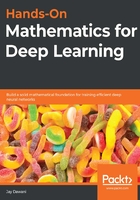
上QQ阅读APP看书,第一时间看更新
Stirling's formula
For the sake of argument, let's say  .
.
We know that the following is true:

However, we now claim the following:

This can be illustrated as follows:

Now, by evaluating the integral, we get the following:

We now divide both sides by  and take the limit as n→∞. We observe that both sides tend to 1. So, we have the following:
and take the limit as n→∞. We observe that both sides tend to 1. So, we have the following:

Stirling's formula states that as n→∞, the following is true:

Furthermore, we have the following:

We will avoid looking into the proof for Sterling's formula, but if you're interested in learning more, then I highly recommend looking it up.